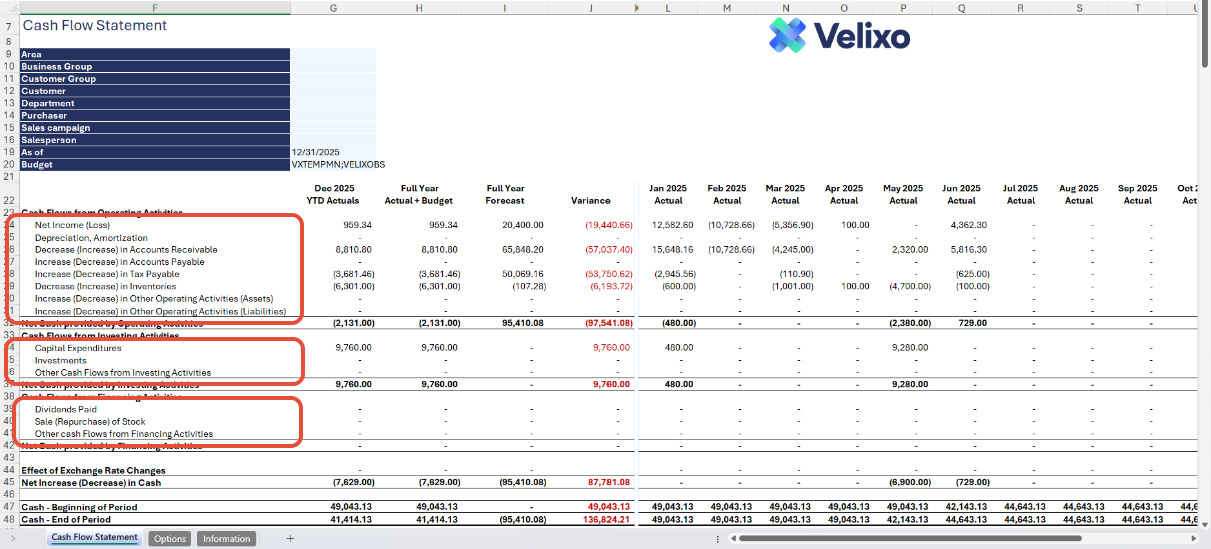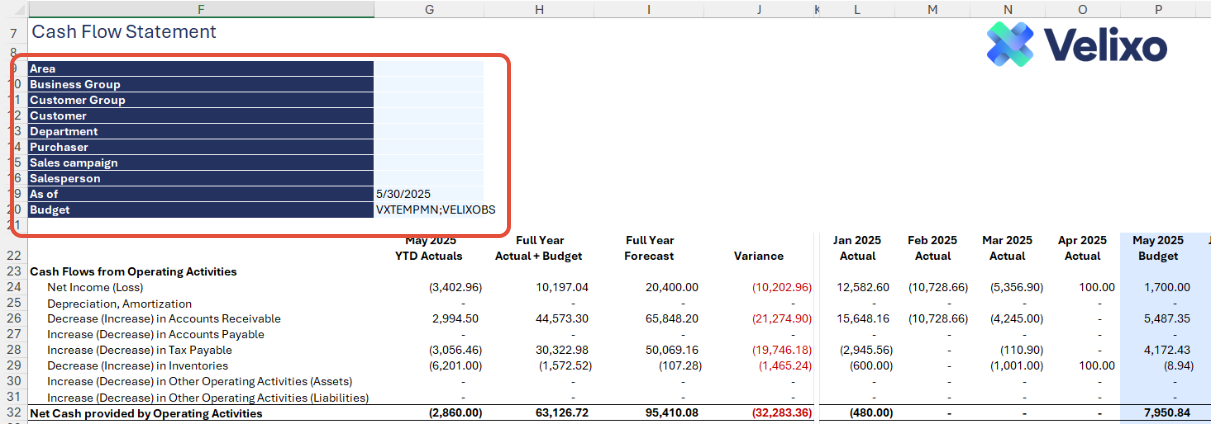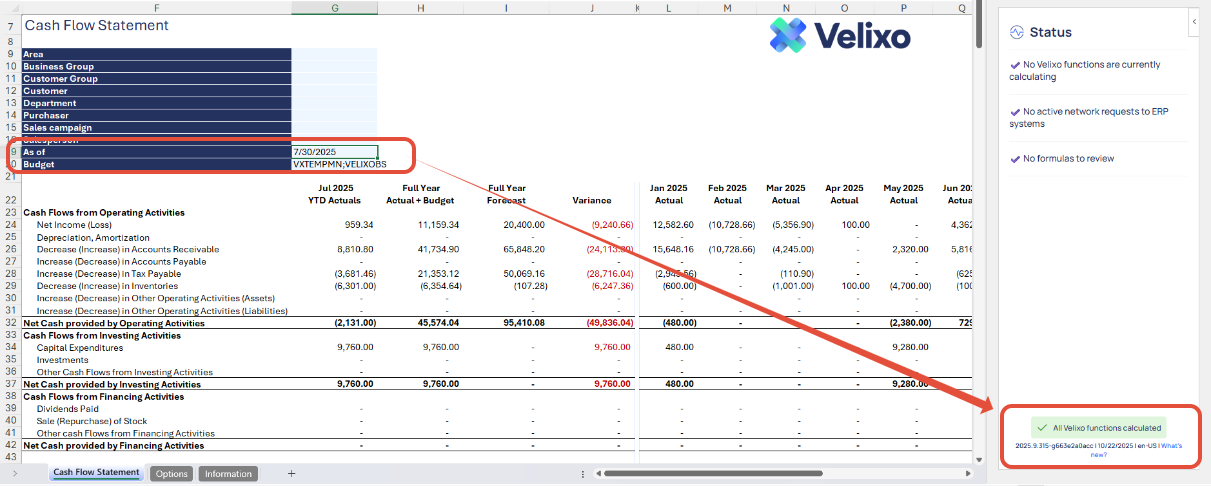BC-GL-RT12 Cash Flow Forecast (budget-based)
Created by Velixo Team, Modified on Thu, 23 Oct at 1:01 AM by Velixo Team
Applies to
- Product version: Velixo NX
- ERP: Dynamics 365 Business Central
- Functional area: Financials, Budgeting, Other
- Plan: All
- Template type: Production Report template
TABLE OF CONTENTS
- Applies to
- Description
- Coverage
- Typical audience
- Features
- Preview
- Download this template
- Documentation
- User Guide
- Version History
Description
The BC-GL-RT12 Cash Flow Forecast (budget-based) is a Velixo financial tool that can project or estimate the future inflows and outflows of cash for a company over a specific period. This report provides valuable insights into a company's liquidity position, enabling stakeholders to anticipate cash shortages or surpluses and make informed financial decisions.
Coverage
This workbook includes the following sheets:
- Cash Flow Forecast: the Cash Flow forecast report, at the granularity of account categories, and reporting on Actuals and Budget data across MTD, YTD, and monthly movements.
- Options: the report's settings sheet that is used for data validation lists and various lookups and configurations.
- Information: the information sheet of the report, used for storing useful details about the report such as code, version, and the article link in order to keep track of the origin of the report.
Typical audience
The typical users of this type of report are Finance professionals: Accountants, CFOs, Controllers
Features
The following features are used by this report. To use this report, please ensure that your Velixo license includes all of them, (or contact Support or Sales):
- Financial functions
- List functions
- Query functions
Preview

Download this template
 Templates will be available for download soon
Templates will be available for download soon
💡Having trouble downloading this file?
Simply right-click on the link and select Save Link As
Documentation
Navigating and utilizing the BC-GL-RT12 Cash Flow Forecast (budget-based) is a very straightforward process, designed for simplicity, genericity and efficiency. The template comes pre-configured with generic account subcategories, streamlining the reporting process with minimal user effort.
Filters
Located in the upper left of the sheet, the filters include:
- Dimensions: lists all dimensions present in Dynamics 365 Business Central instance
- As of (Period): a date field. Please use the last date of a financial period/month
- Budget ID: for usability purposes, Velixo lists all of your Budget Ids in a dropdown list. Should you want to select more than one, you can also concatenate them in the Filter value field.
These filters are seamlessly linked to the data on the Options tab.

Note: The dimension list updates dynamically based on the number of dimensions configured in your instance. However, the template can process a maximum of 10 dimensions per company. If your instance includes more than 10 dimensions, please contact Velixo Support for assistance.
Cash Flow Statement Structure
Sections: Velixo has thoughtfully structured the Cash Flow statement using the most common sections that should be generic, by default.
The following activities are used:
- Operating Activities
- Investing Activities
- Financing Activities

Default line items were added as well per activities and are highly customizable depends on the user’s requirements. These are based on the native Dynamics 365 Business Central cash flow statement report, making it as streamlined with the ERP as possible.

Metrics: The report includes the following metrics:
- On Columns:
- YTD (Actuals) vs Full Year (Actuals + Budget) vs Full Year Forecast
- Col G: the turnover from the beginning of the period up to the date specified in the "As of" filter
- Col H: the total of the Actual and Budget balance from Col K to V
- Col I: the budget turnover balance for the full year
- Variance (YTD Actuals vs Full Year (Actuals + Budget))
- Variance $: the amount difference between the YTD Actuals and the Full Year Actual + Budget totals
- Monthly Movement (Actuals or Budget)
- Col L to W: the turnover for the period and can be the Actuals or Budget based on the date specified on the "As of" filter.
- YTD (Actuals) vs Full Year (Actuals + Budget) vs Full Year Forecast

User Guide
Configuring the report
A quick setup is needed to get the most out of the report. These settings control how balances are pulled from the system and displayed in the report.
Setting Up Account Subcategories or Account Codes/Ranges
Each statement line in the report should be mapped to the corresponding account subcategories or account codes. This mapping defines how Velixo retrieves data from the system. To set this up:
- Expand the grouped columns on the leftmost side of the report

- Doing so will display the configuration columns D and E for the Account Subcategory and Account Code/Range.

- The report includes default subcategories based on the Velixo demo instance. These may not match your company’s configuration. Update the subcategories or account codes as needed to align with your instance setup.
Note: By default, the Account Code takes priority over the Account Subcategory. If both are specified in the configuration, the template will ignore the subcategory and extract balances based solely on the account code.
Using the report
Now that we've covered the report overview, let's dive into a step-by-step guide on effectively utilizing the report:
- Set the Connection Name on the Options Sheet: crucial for all processes, set the Connection Name on the Options sheet by updating cell A2. Ensure it matches the name used during Velixo application login.

- Update the Options Sheet: As the foundation for filters on the Cash Flow Statement sheet, keep the Options sheet up to date. It should always and automatically capture the latest dimensions and structures from your Dynamics 365 Business Central instance.

- Choose Desired Filters:after updating the Options sheet, select desired global filters for the report:
- Dimensions
- As of (Period)
- Budget ID

- Automatic Report Update: selecting any filter will automatically update report balances. Begin analyzing the report with the latest data.

Managing Account Structures
As outlined earlier in this document, users have the flexibility to tailor this report to their specific needs. It is not required but may be useful if the default statement lines don't quite fit the requirements.
Adding a new line item
If users desire a structure beyond the provided default line items, they can leverage account groups set up in their ERP instance. However, caution is crucial to avoid overlap between account subcategories, preventing inaccuracies.
Users have two options when adding new account structure:
1. Re-purposing an existing Account subcategory:
- Rename an existing account subcategory line, replacing it with the desired custom account group.
- Ensure exact naming consistency with the ERP instance for Velixo to accurately return amounts.
2. Adding a Row in the Required Cash Flow Activity Section:
- Use Excel functions to add a new row in the desired section.
- Be cautious with formulas in newly added rows; copying from existing rows in the same section ensures accurate results.
Version History
| Version | Released on | Remarks |
| 1 | N/A. Initial version of this template. |
Was this article helpful?
That’s Great!
Thank you for your feedback
Sorry! We couldn't be helpful
Thank you for your feedback
Feedback sent
We appreciate your effort and will try to fix the article